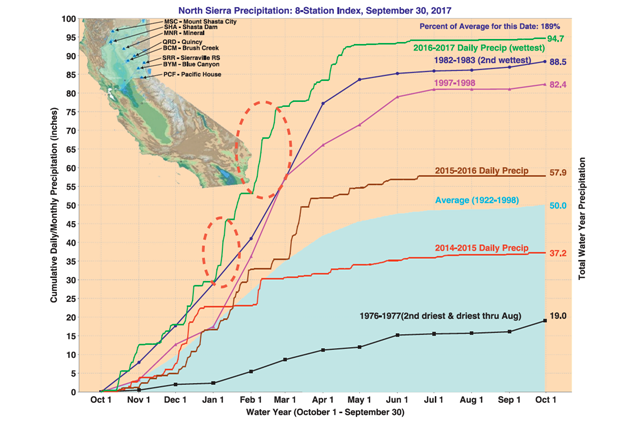CW3E Publication Notice
Hydroclimatic Extremes as Challenges for the Water Management Community: Lessons from Oroville Dam and Hurricane Harvey
December 20, 2018
Members of the American Meteorological Society’s Water Resources Committee, led by Julie Vano (UCAR), and including CW3E Field Research Manager Anna Wilson and CW3E collaborator Mike Dettinger, among others, recently published an article in the 2017 issue of the Bulletin of the American Meteorological Society’s supplement “Explaining Extreme Events from a Climate Perspective,” titled: Hydroclimatic Extremes as Challenges for the Water Management Community: Lessons from Oroville Dam and Hurricane Harvey. This essay was featured in a press conference on the release of the supplement held at the AGU Fall Meeting in December 2018.
In their article, the authors used two examples of hydroclimatic extremes associated with major, climate-change related challenges for communities and power-, water-, and flood-management systems to illustrate their points. These examples, both of which included non-trivial operational components relating to long term land use and infrastructure management decision making, were a sequence of strong atmospheric rivers in California during February 2017 (Figure 1) and an extraordinary hurricane.
A major take-away from the article is a list of key pieces of contextual information to keep in mind during study design in order to make attribution studies more relevant to the water management community. This requires not only attention to the following decision-making context, but sustained engagement with the water management community. The guidelines to keep in mind are: (1) Duration is critical to determining event severity; (2) Temperature characteristics can significantly change the magnitude of the impacts; (3) Real-world relevance can be improved by including case-specific criteria and targets; (4) Both meteorological and operational factors are important in many extreme events; and (5) Attribution studies have the potential to help management navigate an important paradigm shift.
Figure 1: (from Vano et al., 2018). 2016–17 precipitation accumulation for an average of precipitation observations at eight northern Sierra stations, the Northern Sierra 8 Station Index, compared to water years 1983, 1996, 2016, 2015, and 1977 and a long-term average (100 inches = 2540 mm; dashed ovals highlight major January and February storm sequences). Source
Vano, J.A., Dettinger, M., Cifelli, R., Curtis, D., Dufour, A., Miller, K., Olsen, J.A., Wilson, A.M., 2018: Hydroclimatic Extremes as Challenges for the Water Management Community: Lessons from Oroville Dam and Hurricane Harvey. Bulletin of the American Meteorological Society, doi:10.1175/BAMS-D-18-0219.1.

